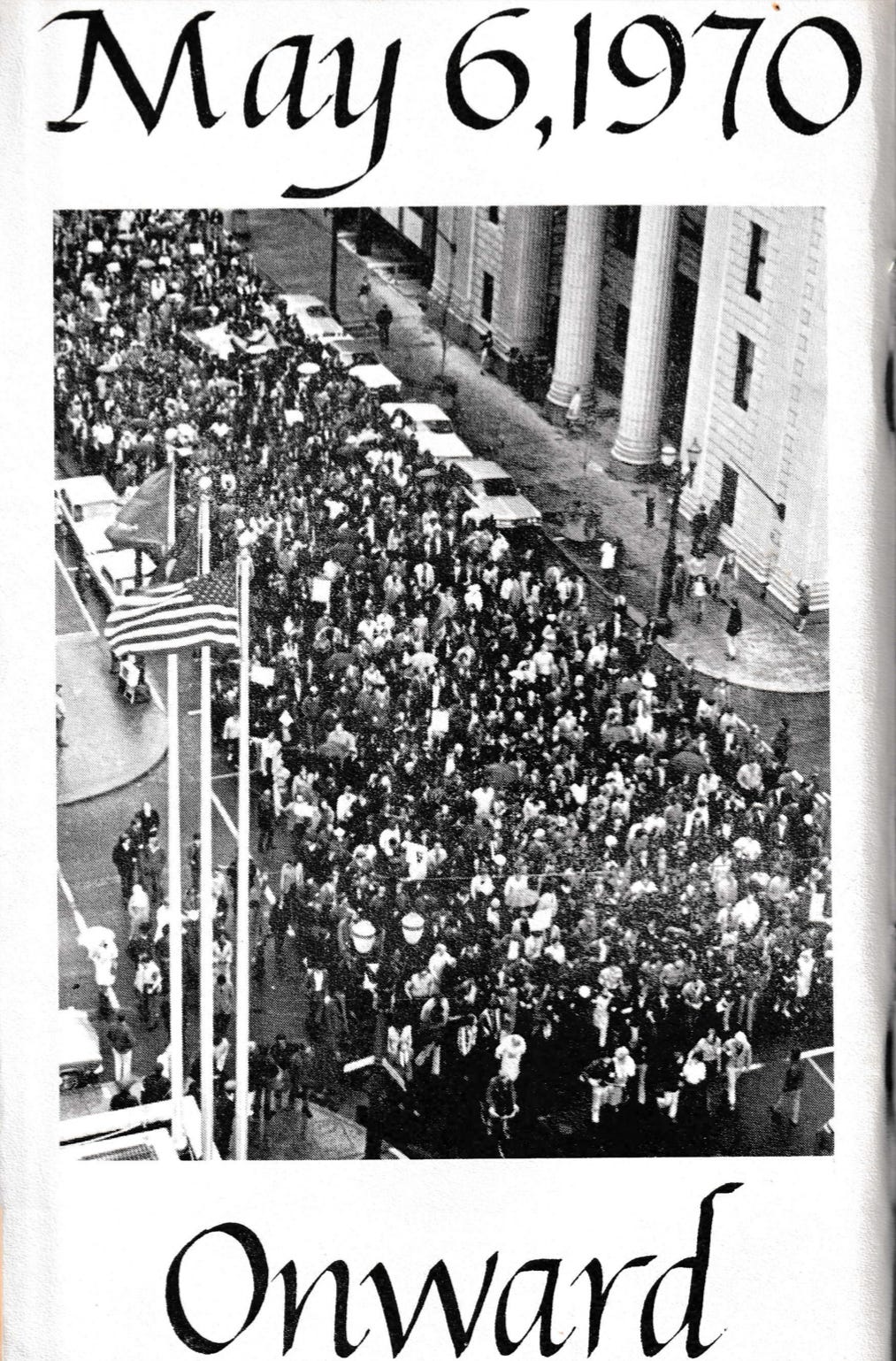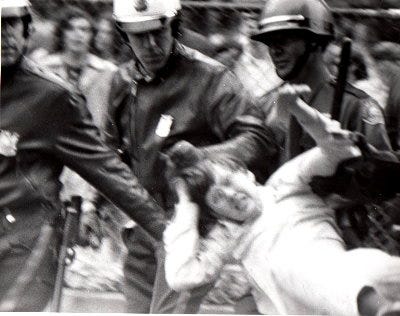Searching for solidarity across time
Student protests at Portland State University, 1970 and today
At the beginning of May, I was having a beer with one of my dad’s friends, a man in his early eighties, and he brought up the Portland State University student strike. I thought he was talking about the protest happening on the PSU campus at that very moment related to the genocide in Gaza. But no! He was talking about the anti-Vietnam War student strike that began on May 6, 1970 at PSU that followed the killing of four students at Kent State two days prior.
I knew a tiny bit about this. A few years ago, my dad mentioned it over breakfast at his apartment during a conversation that meandered wildly, which is to say, in his usual fashion. His friend David Horowitz, a PSU professor, was involved in erecting a plaque to commemorate the strike. (These photos come courtesy of Horowitz via the PSU Vanguard.) At that time, the information slid past me like a car moving in the opposite direction.
But when his friend brought it up, I found myself newly curious. A few hours later, I found myself immersed in the online PSU archive, looking at photos of students facing off against cops who had batons in hand.
I’ve read a number of pundits go out of their way to point out that the anti-Vietnam War protests and those happening today are not identical. That’s not hard to see. Nonetheless, I’m interested in the parallels. Then and now, students were protesting US military incursions abroad, albeit in different forms. There is a through line related to the military industrial complex and its connection to the police.
So what happened in 1970 on the PSU campus, which sits in the heart of downtown Portland? Here is a concise description from a PSU student project from 2015:
On May 6, 1970, Portland State students, with the support of many faculty members, walked out of classes in solidarity with demonstrators nationwide after the killings at Kent State University on May 4. The anti-war movement, protests against military recruiting on campus, actions against the transport and storage of nerve gas in Oregon, and the Free Speech Movement all added momentum to the strike, which lasted several days.
PSU President Gregory Wolfe authorized the closure of campus against the urging of counter-protesters who organized to keep classes open, stating, “Business as usual is no longer tenable.” Protesters barricaded the campus Park Blocks, which were then open to vehicle traffic, to hold speeches and demonstrations.
The strike ended violently on May 11 when a Portland Police riot control squad pushed through lines of seated protesters, beating them with batons. The following day, thousands of Portlanders reacted against the use of force by marching from PSU to City Hall, a presence that belied the degree of community support for the city’s action to clear the barricades.
These events are remembered by many in Portland and at PSU as powerful moments in the history of the university and the city.
My dad’s friend told me that the day following the police attack on a medical tent, which left 31 people hospitalized, 4,000 Portlanders marched in solidarity with the student movement.
My favorite discovery in the archive was this 56-page booklet, produced by the committee that organized the strike, telling their story. I grabbed this image from the final page.
Here is an excerpt from the letter that opens this booklet:
Our primary purpose in putting the booklet together was to give those who built and participated in the strike a document of their efforts. We also hoped that the Portland community could gain some perspective on the strike in the face of the distortions of the local media. [My emphasis.]
Those words feel just as trenchant today. On May 1, 2024, KGW, a Portland-area radio station, interviewed a protester who had been involved in May 1970, who said:
“And the kids today, they may be right about the Middle East and Gaza and and the way the Palestinians have been treated, but they’re smothering their message.”
Weiskopf said he fears reports of vandalism and antisemitism at campuses nationwide can undermine the goals and messages of the demonstrators.
Don’t you just love a patronizing old man telling kids they’re not delivering their message correctly? And don’t you just love when the media reports on someone who “fears reports of vandalism and anti-Semitism” without substantiating what those reports are and whether they’re accurate? This is irresponsible journalism or, as the kids back then called it, “distortions.”
Starting last month, universities around the nation began siccing the police (and the national guard!) on students and professors. Writing in the New Yorker, Keeanga-Yamahtta Taylor counted 2,000 people arrested on at least 46 campuses. “Students have faced cops in riot gear wielding tear gas, pepper spray, tasers, and batons,” Taylor describes. Then, in an act of classic Orwellian double speak, the government condemns student violence.
Here is a photo from the PSU student strike in 1970 taken by Tom Geil. It looks eerily similar to the images we’re seeing today.
It’s worth seeing this history as connected while noting the differences. In an On the Media segment on how “historical analogies distract us from what makes today’s protests unique,” Rick Perlstein pointed out how militarized the police have become in the past five decades. Military equipment and tactics are now the norm. That’s a major difference, but there remains a common feature: the police have played a grotesque and incendiary role in both.
The US students who’ve been interviewed repeatedly cite the destruction of every single university in Gaza as a motivation. On April 17, the UN reported that “more than 5,479 students, 261 teachers and 95 university professors have been killed in Gaza, and over 7,819 students and 756 teachers have been injured.” US students see solidarity across national borders.
Last week, after the cops arrested 31 people at PSU, 4,000 Portlanders did not take to the streets. I did not take to the streets. It felt very different, for a host of reasons. Nonetheless, many of us stand with the students in asking institutions to divest from corporations profiting off of business as usual with Israel and the proliferation of weapons to Israel for its siege of Gaza.
It’s worth noting that the PSU endowment isn’t invested in Boeing. As the Occupy PSU group wrote on Instagram, “While PSU does not put FINANCES into Boeing, they take their money and give them a platform for predatory recruitment.” The students are not a monolith—and why would we expect them to be? I have no interest in silencing thoughtful conversation in good faith. For example, I keep wondering: Why did the PSU protesters choose the library? Of course, they’re the ones to ask.
But again, getting fixated on the details and never looking up is missing the forest for the trees. I’m asking those people who may not agree with each group of student’s exact demands or rhetoric to keep their eyes on the big picture—on the more than 34,900 Palestinians who the Israeli military has killed and 78,500 who they’ve injured using US weapons and military equipment.
The students want what’s happening in Gaza to end, now. And don’t you?









I grew up in the middle of the anti-Vietnam and then anti-nuke protests with parents who were deeply involved in the peace movement. It's easy for me to take that for granted and not realize that most other people have a very different perspective on public protest, largely less perspective on the inner workings, strategies, and even just that there are often conflicting views within groups protesting the same thing. Largely the point of protest is public awareness - which is amplified by the press, especially when police are involved. My father recently sent me a recommendation of a book a friend of his wrote on his experience with Vietnam era protests and more. I also chose when I was 18 to commit a felony as protest and not register with Selective Service. While I did make it into the local and national news for the choice, I never chose to make it an ongoing issue and thus it only comes up occasionally. I haven't followed the student protests closely but I do hope the organizers are learning from history, as has been tradition repeatedly through time. The Vietnam peace movement was certainly informed by the civil rights movement, which was heavily influenced by the Ghandi's Indian independence movement, to mention but a very few... https://www.tworiversbooks.com/search/Felon%20for%20Peace
Thanks for unearthing these great photos. As someone who went to high school in Kent Ohio I've been thinking about these parallels a lot recently.
I also often wonder what critics think would be the "right way" to deliver a protest message: silently/invisibly/ineffectively?